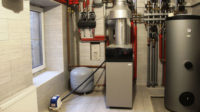I had written a story for Plumbing & Mechanical a while back about a fella in Canada who sent me this email:
"Our problem is that five out of hundreds of univentilator coils freeze up on a regular basis. They are part of two pipe steam systems with pneumatic control valves and condensate pumps. The F&T traps have been replaced and the coils are grading down to the returns. The traps on some are two feet or so below the coil outlet. The boiler pressure on all buildings runs between 4 psi and 8 psi and the boiler shuts down at night until the coldest room in the building requires heat. If the outside temperature falls below -15 C the boiler stays on pressure. Do you have any ideas on how to solve this problem?"
I wrote back and told him that he should look and see if there's a vacuum breaker between the control valve and univentilator. Vacuum breakers do exactly what their name implies, and vacuum is what you get when steam condenses, unless air can get back in to break it. And unless you're dealing with a mechanical vacuum system, vacuum is not your friend.
What's going on in that coil is exactly what goes on when you hold your finger over the top of a straw that's filled with water. Think of your finger as the vacuum breaker. Lift your finger and gravity does the rest.
But when it comes to steam coils, you can't depend entirely on gravity to get rid of the condensate. The guy in Canada said that his traps are two feet below his coils, right? Okay, think like condensate. You're building up inside the coil. The control valve is closed because the space is warm enough. The vacuum breaker just opened. You now have just two feet of vertical pipe available for you to stack and build static pressure. How strong are you feeling right about now? You're producing less than 1-psi pressure down there at the bottom of your stack, aren't you? There's a float & thermostatic steam trap down there and you're pressing against it with a measly 1-psi pressure
Feeling wimpy?
Me too.
My thoughts were that even though I’m 73 years old and have worked with steam for 53 years I still have a lot to learn from my betters.
And all of this assumes that the vacuum breaker is in place and working, of course. If it's not, there will be a vacuum tugging you back into the coil and there will be little or no pressure on the inlet side of that F&T trap, which is why vacuum breakers are so important.
So after that story appeared in the magazine, I got an email from a reader, Ray Cosgrove, who is a lot smarter than I am when it comes to steam coils. He wrote, “Hi, Dan. What you said about the vacuum breakers might work to prevent freezing, but probably won’t if the system is more than two years old. I sell $500,000 worth of steam coils every year and I always find the reasons why they freeze; and when I do, none of my coils ever freeze again.”
Ray challenged me to tell him why the vacuum breaker I described wasn’t the best idea, but I couldn’t think of a thing, so I asked him to please teach me.
Ray retired from Affiliated Steam and Hot Water in Alsip, Illinois last November. He said he figured 44 years and 1 month in the pipe trades was long enough. He spent his first 21 years in the Plumbers & Steamfitters Local 387 (now LU25) as an HVAC/R service tech, and then another 23+ years at Affiliated Steam & Hot Water as a manufacturers’ rep.
He’s seen much more of the real world than I have, so I did what I usually do: I shut up and listened.
“We have conducted steam seminars in our Chicago demonstration room for more than 30 years,” he told me. “A lot of what you mentioned we discussed. Where I see vacuum breakers mostly installed (because it comes from most OEMs like Trane in old literature) is between the control valve and coil, as you mentioned. Humorously, in Trane’s old literature they call for a 15-degree swing check at the coil inlet. So does L. J. Wing. I guess I’ve never stumbled across a 15-degree swing check. Regardless, you want it to open just as the needle dips below zero on the pressure gauge
“In nearly 100% of the cases, unless the coil is shoebox-tiny, you will have a pressure drop between the inlet and outlet of the coil. Hence, if the vacuum breaker is installed where you mentioned on modulated steam you could have 1/8th- to ¼-psi steam pressure at the coil inlet due to a satisfied load (especially during mild weather), and a vacuum at the outlet. The coil will either freeze if it’s 28 degrees, as it is in my area, or water hammer and then fail. For sure it won’t drain as you mentioned.”
I nodded and shut up even tighter because, as I mentioned, Ray is one smart fella when it comes to this topic, and I am still learning, even after all these years.
“Here’s another scenario that happens after a year or so,” he continued. “Most control valves are a Class-IV shut off. These are not bubble-tight, like a Class-VI piston- or ball valve. They will leak through, especially if the valve and seats are wiredrawn. Now, when a coil-control valve is either shut because the thermostat is satisfied or the steam is on all year (such as in a hospital), a vacuum breaker at the coil inlet will never open because it’s always seeing a slight positive pressure from a leaking control valve. The coil will fill with condensate and you’ll either get a water hammer when the control valve opens in the fall, or pinholes in the tubes from cooled condensate that has turned to carbonic acid. What are your thoughts on that?”
My thoughts were that even though I’m 73 years old and have worked with steam for 53 years I still have a lot to learn from my betters. I was so glad that Ray wrote to me and I told him so.
Ray laughed and reminded me that someday we’ll both be Dead Men and it’s good to try to pass on what we know. I couldn’t agree more.
What are your thoughts on that?







